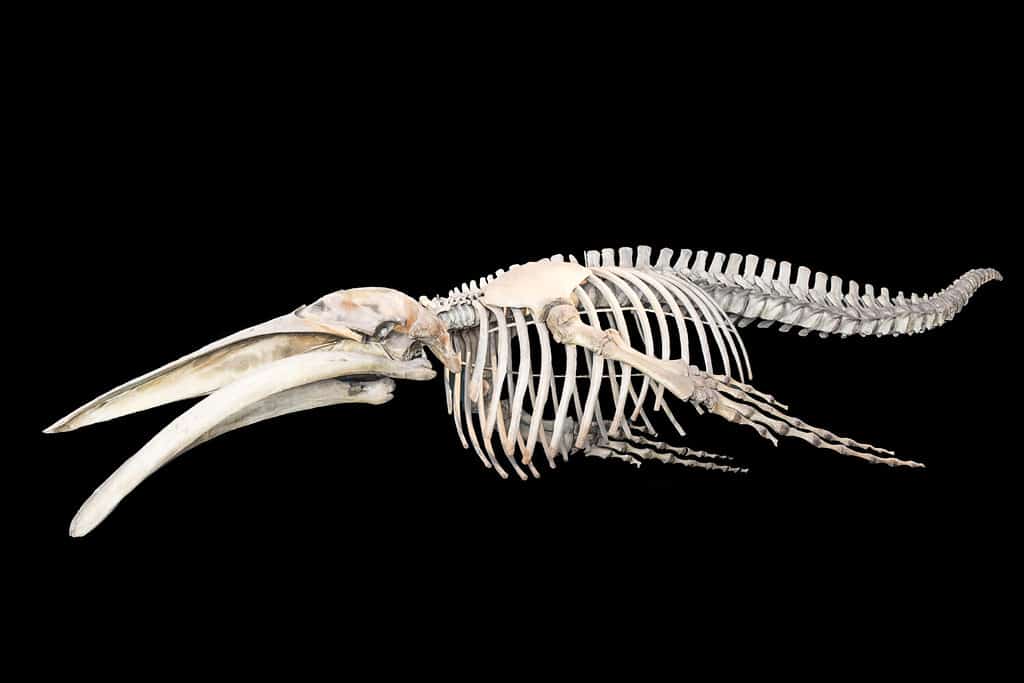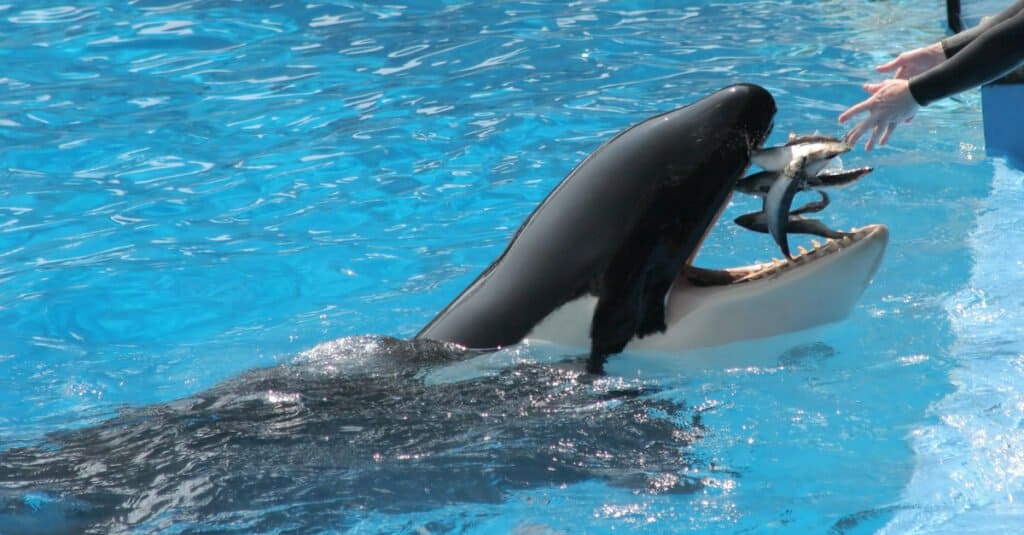For centuries, the idea of sea monsters and vicious whales has run rampant in urban legends. However, none have felt so realistic and prominent as that of Porphyrios. This whale was certainly special, with an intense affinity for destroying anything and anyone who dared come into its path.
So, should you care to hear the tale, let us regale you with the legend of Porphyrios. Its intense origins, its interesting lore, and its tragic demise.
The Origins of the Legend

Porphyrios was thought to live many years ago, all the way back in the sixth century.
©Gilda Villarreal/Shutterstock.com
The legend of the infamous Porphyrios comes from the writings of Procopius, a sixth-century Byzantine historian. His works History of the Wars and Secret History are what contain the bulk of the information. Essentially, due to a historic lack of knowledge regarding what exactly whales were and what exactly they were capable of, many assumed whales to be a kind of sea monster. Porphyrios was one such monster and a terrifying one at that.
For over fifty years, Constantinople was threatened and attacked by the whale in sporadic bursts. Though it moved around quite a bit, it mostly resided in the Bosporus Strait and the Black Sea. The key distinction between Porphyrios and other whale-related legends is that, unlike other whales that were known to exclusively attack and destroy whaling ships, Porphyrios did not discriminate in its targets. Whether it was an army ship, a merchant ship, or even a simple fisherman, Porphyrios was there to attack whenever he pleased.
Naturally, this was upsetting to the residents of the area at the time. Despite taking some years off, there was always a sinking fear that Porphyrios would come back for more. Unfortunately, he often did. This resulted in less trading and less food returning home to the people. The collective fear became so severe that Emperor Justinian I himself ordered the whale to be vanquished. The trouble was that, of course, no one had any idea how they could accomplish such a feat.
Where Did Porphyrios Get His Name?
There is much debate on the topic of where the name “Porphyrios” actually originates. That being said, there are quite a few strong theories. The most common, and the most accepted, is that the name comes from the word porphyria. This word translates to deep/imperial purple in Greek. This, of course, eludes to the whale’s coloring.
The other theories are interesting too. Some believe that Porphyrios got his name from Pophyrius, a charioteer who was quite popular in the same era. Another potential explanation for the name “Porrphyrios” is its association with a mythological giant named Pophyrion. This giant was known for launching an attack on Greece during the Gigantomachy, a mythical battle between the gods and giants.
Do Whales Normally Attack Boats?

The most popular food among whales are small aquatic creatures like fish, squid, and krill.
©Lori Skelton/Shutterstock.com
Though their size may be intimidating, whales are known to be relatively calm and peaceful animals. Many legends might suggest otherwise, but the truth is that whales prefer snacking on small aquatic animals such as fish, squid, or krill. There are no known instances of whales eating human beings or even their body parts. Chances are, if you were to encounter a whale on your seabound adventures, it would be a positive interaction.
Of course, like any animal (or person), a whale will defend itself if you are attacking it. But, this is a rare instance. More often, whales are known to fight amongst each other over things like food accessibility rather than attacking humans nearby. Even if you are startled, it is more likely that the whale is more scared of you than you are of it.
However, it should be noted that whales in captivity have been known to exhibit occasional outbursts. The exact causes of these outbursts, whether they stem from stress or frustration, remain unknown. Nevertheless, there have been documented instances of whales attacking their trainers.
Was Porphyrios a Sperm Whale or an Orca?

Though sperm whales prefer not to live in the Black Sea, it is still a habitat for many orcas.
©slowmotiongli/Shutterstock.com
Through the varying descriptors given to us by Procopius, the common belief about Porphyrios is that he was a sperm whale. The factors that indicate such include the whale’s size, lifespan, and temperament. In particular, a normal sperm whale’s massive stature aligns fairly accurately with expectations, measuring 15 ft in width and an impressive 45 ft in length.
Due to Porphyrios’ geographic location in the Black Sea, it is impossible to accurately determine the species of whale he belonged to. The documentation states that the whale appeared multiple times in the area. However, it is entirely uncommon for a sperm whale to venture there. While orcas are commonly found within the Black Sea, the space is simply not large enough for sperm whales to reside in. Thus, some assume that Porphyrios was simply a particularly large orca.
The last determining factor only makes things seem all the more vague. In terms of Porphyrios’ coloration, many presume it to be a dark purple. This color is a common misconception to those seeing the dark-brown shade of a sperm whale or the black of an orca. Meaning it truly could be either of the two species.
Was Porphyrios the Inspiration for Moby Dick?
With such a hefty and dramatic tale on its shoulders, Porphyrios seems the most likely inspiration for the classic novel Moby Dick by author Herman Melville. In actuality, there was an entirely different whale legend that struck inspiration for the book.
The Essex, a whaling ship from 1820, was attacked by what the surviving crew described as a massive killer whale. Of the 21 crew members, a mere eight were left to bring their tragic tale home. This story, it seems, is what truly inspired Melville.
The name “Moby Dick” originated from a real whale, “Mocha Dick.” Dick and Tom were both fairly common names that sailors would give to whales they happened to come across on their travels. Whales’ fantastical proportions contribute to their common depiction as cruel sea monsters in media like Moby Dick and the legend of Porphyrios.
The Tragic End of Porphyrios

©Animalgraphy/Shutterstock.com
Every great story needs a worthy conclusion, right? According to Procopius’s tale, the legend of Porphyrios ends with the whale inadvertently ensuring its own downfall. While chasing dolphins, the whale simply got too close to shore and beached itself.
Porphyrios wriggled and writhed, but in the end, doing such only cemented it further into its demise. The townspeople quickly spread the word that the legendary whale was beached, and in a fit of collective rage, they gathered weapons and prepared to attack. Unfortunately, the ropes and knives they brought were too dull to cut through the gigantic creature. So, they had to think of something more powerful.
The townspeople experienced a sense of triumph and immense satisfaction upon successfully eliminating the threat of Porphyrios, despite the gruesomeness of the situation. Although Procopius did not mention it in his writings, it is likely that the whale had already perished before being hauled up the beach. While the legendary whale met an unflattering end, its story is forever immortalized in Procopius’ writings, ensuring that it will be remembered for a long time to come.
The photo featured at the top of this post is © slowmotiongli/Shutterstock.com
Thank you for reading! Have some feedback for us? Contact the AZ Animals editorial team.







